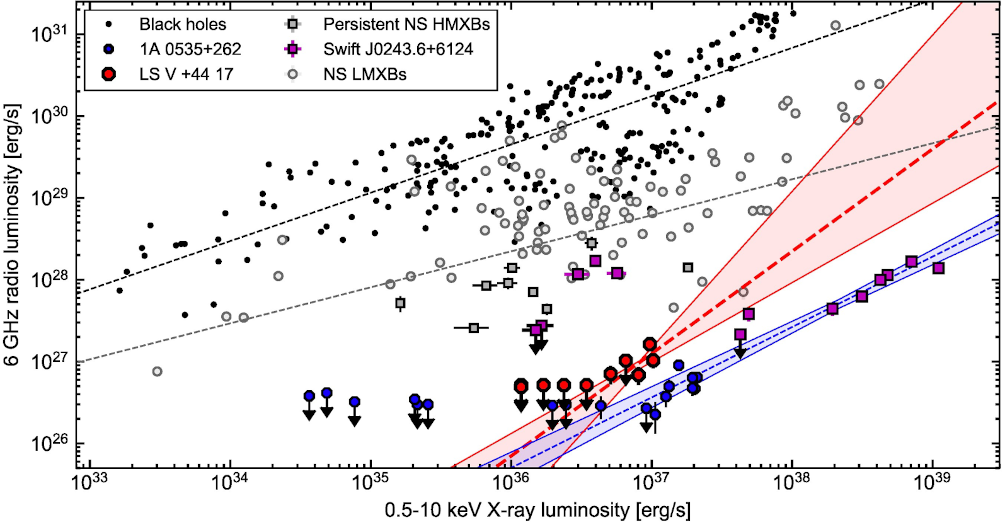NICER / ISS Science Nugget
for December 21, 2023
Launching jets: the X-ray binary puzzle
Accreting binary star systems that shine in X-rays are grouped according to the nature of both the mass donor star and the star that captures the transferred matter. The primary grouping is between accreting black holes (BH) vs. neutron stars (NS). Another division groups the orbiting companion stars by mass: in low-mass X-ray binaries (LMXBs), the typical donor star has a mass a few tenths that of our Sun, while in high-mass binaries (HMXBs) the companion may be several or many times the Sun's mass. Dozens of BH-LMXBs and NS-LMXBs are known; only a few BH-HMXBs and perhaps a dozen NS-HMXBs have been confidently identified. The fluid-flow processes in accretion must have some commonality between these types of systems, but the details of the stellar types also matter: for example, neutron stars have surfaces and strong magnetic fields, which black holes completely lack, and massive stars generally drive "wind" outflows of matter, sometimes confined to equatorial disks, complicating the accretion picture when they are in close binaries. Finally, some systems are persistent "always on" emitters, while most only appear during outbursts that can last months.
An apparently common, but usually short-lived, feature of accreting systems is the presence of jets: high-energy particle flows that are launched in a narrow, collimated beam from the near environment of the accreting star. Radiating energy via a mechanism known as synchrotron emission and visible at radio and infrared wavelengths, these jets can extend extraordinary distances, but the process by which they are generated and collimated remains a mystery. One approach to answering open questions is to better understand precisely when the jets are launched, using the X-ray evolution of an outburst to provide context: X-ray emission tracks changes in the flow of hot matter within both the accretion disk and a highly energized gas known as a corona. A study led by J. van den Eijnden (Univ. of Warwick) and collaborators, recently published in the peer-reviewed UK journal Monthly Notices of the Royal Astronomical Society, collects past coordinated radio/X-ray measurements of BH and NS binaries at various stages of their outbursts and combines them with new measurements to explore how well they are correlated. Their radio and NICER measurements of LS V +44 17, a NS-HMXB that NICER monitored extensively during its brightest-ever outburst in late 2022/early 2023, show that radio and X-ray brightness track each other during the second half of the outburst, but with a relationship that is not consistent with existing theories that link jet power to neutron-star spin or magnetic field strength. Instead, the authors explore the possible impact of ambient gas density, due to a donor-star wind, on radio brightness, and describe the need for further measurements of additional systems to fill in the missing pieces of this puzzle.

For multiple X-ray binaries and at different stages of their outbursts, measurements of brightness in X-rays and at radio wavelengths (with the Jansky Very Large Array in New Mexico) display correlated behavior within each type of system but with substantial scatter. New radio observations of NS-HMXBs coordinated with NICER (red and blue points) are revealing especially large scatter and inconsistent trends (red and blue sloping lines and shaded regions) between objects of the same type. Because radio emission occurs during the launching of jets, these discrepancies suggest that details about the mass-donor star, such as whether it drives a powerful stellar wind, may be important in the formation of a jet. (Figure credit: Van den Eijnden et al. 2023)
<< Previous
Main Index
Next >>